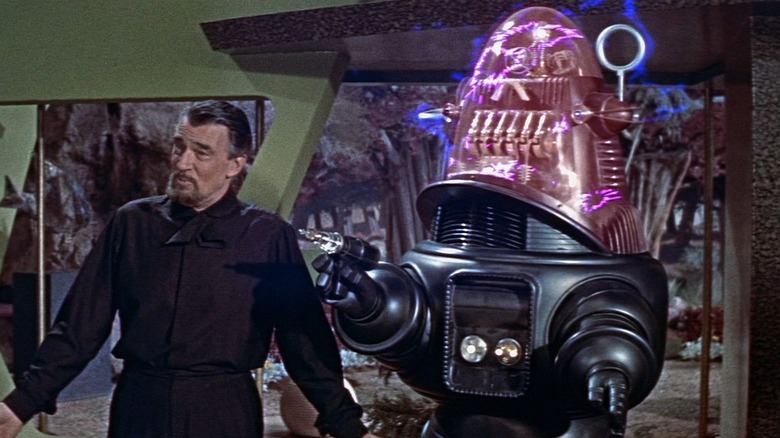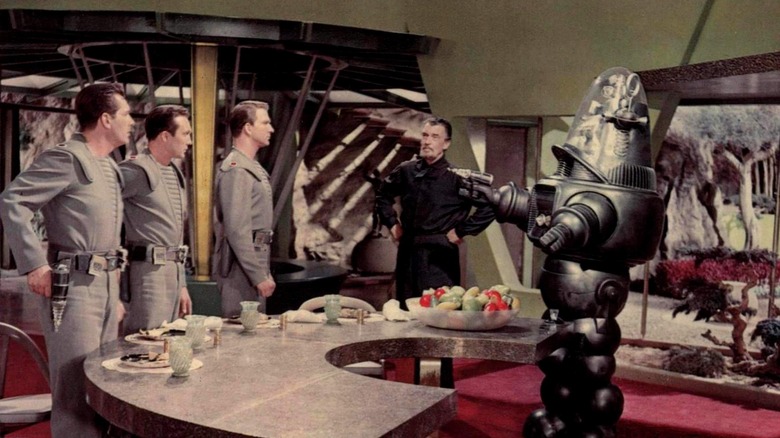How Forbidden Planet Tricked MGM Into Funding Its Elaborate, Expensive Sci-Fi Sets
Fred M. Wilcox's 1956 sci-fi classic "Forbidden Planet" was a notably opulent affair, at least as sci-fi films go. Its budget at the time was only $1.96 million (which shakes out to about $22 million today) comparatively small to the historical epics Hollywood was overspending on at the time; "The Ten Commandments," for instance, cost a whopping $13 million, while 1956's Best Picture winner, "Around the World in 80 Days" cost about $6 million. "Forbidden Planet" was a production on par with 1953's "War of the Worlds," a colorful, large-scale production infused with fantastical spacecraft and weird robots. Robby (voiced by Marvin Miller), the robot featured in "Forbidden Planet," reportedly cost $125,000 to make — about a million in today's dollars.
The production designer on the film was Arthur Lonergan, the Oscar winner behind "The Oscar." Prior to "Forbidden Planet," Lonergan had an extensive career working on shows like "Mr. & Mrs. North," and on low-profile films like "Black Beauty," "Cause for Alarm!," and "Young, Rich, and Pretty." It seems that "Forbidden Planet" afforded Lonergan to stretch creatively, building massive, futuristic sets that hadn't been seen on screen before. The home belonging to Dr. Morbius (Walter Pidgeon) a was vast, sweeping Googie masterpiece that housed both high-tech widgets and natural lagoons.
In the 2006 documentary short "Amazing! Exploring the Far Reaches of Forbidden Planet," it was revealed that Lonergan kind of knew that Metro-Goldwyn-Mayer would pay for the kinds of buildings he envisioned. Thanks to a connection with the MGM higher-ups, however, Lonergan seemed to know that he would be able to work unsupervised and charged ahead without clearance. Better ask for forgiveness than permission, right? The story was related by "Forbidden Planet" fan William Malone.
Better to ask for forgiveness than permission
Malone is a well-known collector of "Forbidden Planet" tchotchkes and memorabilia, so he was the right person to ask about the background of the film. He knew all about Longergan's enthusiasm for sets and building, and how he charged ahead without worrying about the budgets for the film. Malone told the following story:
"Cedric Gibbons, who was the head of all the art directors at the studio, he left Arthur Lonergan alone to be the art director on the film. And Lonergan really grabbed a hold of it and said, 'This is a great opportunity to make something really cool.' One of the things that he did was he actually had sets built that were way bigger than what they had in the budget, and was able to get them about half-built before the budget department came down on him. So they built all these really elaborate sets, and then they had to finish them because they were already half done."
So if the studio didn't like the sets Lonergan was building, it would now be more expensive to tear them down and start over than it would be to just let him finish. MGM — one might think begrudgingly, let him finish. "Forbidden Planet" star Leslie Nielsen recalled the size and scope of the sets well, understanding that MGM was pouring a lot of money into the production. Nielsen recalled specifically the flying saucer, and how it was a near life-size craft they lowered from the ceiling to the ground on a massive moving cylinder.
The investment was worth it, as "Forbidden Planet" made almost $3 million at the box office and became a pivot point in cinema history.

